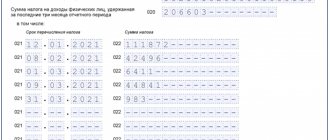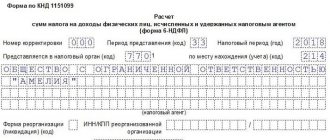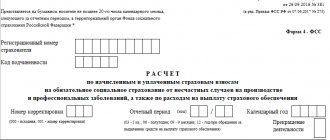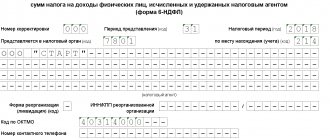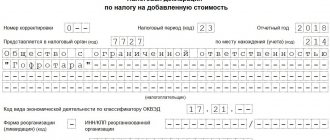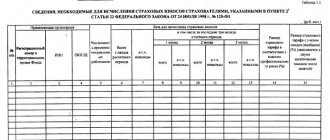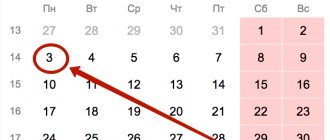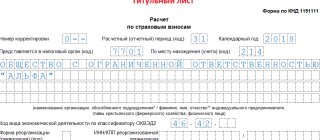How to show compensation from the Social Insurance Fund in the RSV
Starting from 2021, when filling out the DAM, the Form and Procedure approved by Order of the Federal Tax Service of Russia dated October 10, 2016 No. MMV-7-11/ [email protected]
The procedure for filling out the RSV 2021 (reimbursement from the Social Insurance Fund) states that the amounts of insurance premiums for VNiM (insurance in connection with temporary disability and in connection with maternity) are reflected in Appendix 2 to Section 1 of the Calculation.
In accordance with clause 11.14 of the Procedure, in line 080 of Appendix 2, you must indicate the amount of compensation from the Social Insurance Fund in the column corresponding to the month of actual compensation.
Thus, if the Fund reimbursed the employer’s expenses for paying benefits in August 2021, then this should be reflected on line 080 in the column for the 2nd month of the 3rd quarter. We will describe in detail how to do this in an example.
In the final line 090 of Appendix 2, you must indicate the amount calculated using the following formula:
This reflects the difference between accrued contributions and expenses for payment of benefits plus the amount of compensation from the Social Insurance Fund for the reporting period.
Calculating the difference can result in either a negative or a positive number.
There is no need to indicate the amount with a minus sign in front in the calculation! Only the difference is indicated, and you need to show whether it is negative or positive using the numbers 1 or 2, entered in the “sign” columns:
- 1 - premiums are greater than the cost of insurance payments to employees;
- 2 - the cost of insurance payments is greater than the accrued premiums.
So, if you get a negative value, put the number 2 in the “sign” column. This will mean that the amount of benefits you transferred is greater than the amount of insurance premiums.
Please note that at the end of the reporting period, the result will be either an amount payable to the budget (positive) or reimbursement from the budget (negative). They will be indicated with attributes “1” and “2” respectively. In this case, you cannot simultaneously fill in the calculation lines:
- 110 and 120;
- 111 and 121;
- 112 and 122;
- 113 and 128.
When you receive the amount to be paid, fill out line 110, and for reimbursement, fill out line 120, and so on.
How many lines with number 030 in the report on insurance premiums
The current form of the report on insurance premiums, submitted to the tax service on the 30th day of the month following each quarter of the year, contains the order of the Federal Tax Service of Russia dated September 18, 2019 No. ММВ-7-11 / [email protected] The form includes 3 sections, dedicated:
- the final figures of calculations, which provide 10 annexes disclosing the details of the consolidated assessments of contributions on income paid to employees;
- information submitted for peasant farms, to which there is only one attachment reflecting data for each member of the peasant farm;
- personal information on the calculation of contributions for each of the employees.
Section 2, concerning existing peasant farms, is filled out by them only once - at the end of the year (clause 3 of Article 432 of the Tax Code of the Russian Federation), and they do not use other sections of the report. Other employers, when forming the calculation of contributions, must necessarily enter data into sections 1 and 3, but out of the 10 appendices to section 1, not all will be filled out with them, since in addition to those that are required to be submitted, there are also those that are filled out only if there is information to be entered.
Line number 030 is present in each section of the report and in each of the appendices provided in it, except for appendix 6 to section 1. That is, the total number of lines with this number in the report is 17.
ConsultantPlus experts spoke about the nuances of filling out each line of the DAM. Get trial access to the K+ legal reference system and check for free whether you filled out the report correctly.
Main innovations in the form of DAM
The updated form appeared for several reasons. The main one is the amendments made to the Tax Code.
Firstly, starting from 2021, the DAM includes data on the average number of employees. They are reflected on the title page. This is due to the fact that the self-report with this information has been cancelled.
Secondly, in 2021 a number of insurance premium rates were changed. For small and medium-sized businesses, the aggregate rate was reduced by half. For those areas that suffered the most from the coronavirus crisis, zero insurance premium rates were in effect in the first half of 2020.
In this regard, the tax service previously recommended indicating new payer tariff codes in the DAM form: 20 – for SMEs; 21 – for those that belong to the most affected industries; 22 – for electronics / radio electronics developers.
In addition, to reflect in section 3 of the KND form 1151111, new codes for insured persons were introduced, corresponding to payer tariff codes 20-22:
- MS. Serves to indicate the portion of the payment exceeding the minimum wage to an employee of a small or medium-sized enterprise;
- KV. Used to reflect payments from which insurance premiums were calculated at a zero rate;
- ECB. Used to reflect employer payments related to IT/electronics development.
The above changes must be taken into account when filling out the DAM for the 4th quarter of 2021.
Another innovation: from 14% to 7.6%, tariffs for calculating contributions for employee insurance for organizations in the field of high technology and electronics development were reduced. For this category of payers, the new DAM form contains a separate section - Appendix 5.1.
Calculation of contributions for 9 months
The base for the second quarter cannot be excluded from the calculations. The fact is that the base is taken into account for each individual on an accrual basis from the beginning of the year. This allows you to track the moment when it exceeds the limit value. How many tariffs are applied in the billing period does not matter.
If we are talking about a SME, then when calculating contributions for 9 months, he can apply a reduced tariff (Federal Law dated 04/01/2020 No. 102-FZ). You can calculate using the formulas proposed by the tax office (letter from the Federal Tax Service dated April 29, 2020 BS-4-11/ [email protected] ). In the third column we showed how these formulas can be presented taking into account zero tariffs for the second quarter.
| For what period do we calculate insurance premiums? | Formula | How can you present the formula taking into account the zero tariff for the second quarter? |
| July | Base (for 3 months) x 30% + minimum wage payments for 4 months x 30% + (Base (for 7 months) – Base (for 3 months) – minimum wage payments for 4 months) x 15% – insurance premiums calculated for January -June | Base (for 3 months) x 30% + Base (April-June) x 0% + minimum wage payments for 1 month x 30% + (Base (for 7 months) – Base (for 3 months) – Base (April-June) – minimum wage payments for 1 month) x 15% – insurance premiums calculated for January–June |
| August | Base (for 3 months) x 30% + minimum wage payments for 5 months x 30% + (Base (for 8 months) – Base (for 3 months) – minimum wage payments for 5 months) x 15% – insurance premiums calculated for January -July | Base (for 3 months) x 30% + Base (April-June) x 0% + minimum wage payments for 2 months x 30% + (Base (for 8 months) – Base (for 3 months) – Base (April-June) – minimum wage payments for 2 months) x 15% – insurance premiums calculated for January–July |
| September | Base (for 3 months) x 30% + minimum wage payments for 6 months x 30% + (Base (for 9 months) – Base (for 3 months) – minimum wage payments for 6 months) x 15% – insurance premiums calculated for January -August | Base (for 3 months) x 30% + Base (April-June) x 0% + minimum wage payments for 3 months x 30% + (Base (for 9 months) – Base (for 3 months) – Base (April-June) – minimum wage payments for 3 months) x 15% – insurance premiums calculated for January–August |
Calculation example
Given
Suppose that from January to March an employee received 40,000 rubles per month. And from April to September he was paid only the minimum wage plus the regional coefficient, that is, only 13,949.50 rubles per month.
Contributions to OPS for July
(40,000 x 3) x 22% + ( 13,949.50 x 3) x 0%
+ 12,130 x 22% + (175,798 - 120,000 -
41,848.50
- 12,130) x 10% - 26,400 - 0 = 26,400 + 0 + 2668.60 + 181.95 - 26,400 - 0 = 2 850.55
Contributions to OPS for August
(40,000 x 3) x 22% + ( 13,949.50 x 3) x 0%
+ (12,130 x 2) x 22% + (189,747.50 - 120,000 - 41,848.50
-
12,130 x 2) x 10% - 26,400 - 0 - 2,850.55 = 2,850.55
Contributions to OPS for September
(40,000 x 3) x 22% + ( 13,949.50 x 3) x 0%
+ (12,130 x 3) x 22% + (203,697 - 120,000 -
41,848.50
- 12,130 x 3) x 10% - 26,400 - 0 - 5,701.10 = 2,850.55
Who submits the DAM for the first half of 2021?
Calculation of insurance premiums (DAM) has been introduced since 2021. It replaced several forms that were canceled after the transfer of insurance premiums to the tax authorities: RSV-1, RSV-2, RSV-3 and partially 4-FSS.
Employers making payments must submit the DAM for the first half of 2021:
- employees working under employment contracts (regardless of its validity period);
- persons with whom GPC agreements have been concluded;
- authors of works under copyright contracts;
- “physicists” under agreements on the alienation of the exclusive right to certain results of intellectual activity, publishing license agreements, license agreements on granting the right to use the results of intellectual activity.
The following employers submit RSV:
- organizations;
- separate sections of Russian organizations that independently pay income to their employees and pay contributions to the budget from it;
- separate units of foreign organizations operating in Russia;
- IP;
- heads of peasant farms;
- an individual without individual entrepreneur status.
Zero RSV is given by:
- the only founders who simultaneously work as general directors (Letter of the Ministry of Finance of the Russian Federation dated June 18, 2018 No. 03-15-05/41578);
- organizations or individual entrepreneurs, if they had no activities and no payments to employees during the reporting period (Letter of the Federal Tax Service of the Russian Federation dated 04/03/2017 No. BS-4-11/6174);
- heads of peasant farms in the absence of employees and activities (Letter of the Federal Tax Service of the Russian Federation dated December 25, 2017 No. GD-4-11 / [email protected] ).
You can find out about changes in the procedure for filling out the zero RSV in 2021 here.
Individual entrepreneurs, lawyers, private notaries who do not have employees do not submit insurance premium calculations.
Results
The report on insurance premiums has 17 lines with code 030. They are present in almost all of its structural parts (sections and applications), but have different contents, implying (depending on the specific location) the indication of both digital and text data.
The greatest difficulty in filling out is line 030, allocated in Appendices 1 and 2 to Section 1, in which five amounts are required to be shown. You can find more complete information on the topic in ConsultantPlus. Free trial access to the system for 2 days.
Filling out section 1 “Calculation of accrued and paid insurance premiums” of the Calculation
When completing section 1:
Balance at the beginning of the billing period
- for reporting forms submitted by the payer of insurance premiums for the reporting (calculation) periods of 2014:
the values of columns 5 - 7 of line 100 must be equal to the values of columns 4 - 6 of line 150 of the Calculation for the previous billing period;
the value of column 3 of line 100 is equal to the value of column 3 of line 150 for the previous billing period in the event of an overpayment for the previous billing period;
the value of column 4 of line 100 is equal to the value of column 3 of line 150 for the previous billing period in case of debt;
the value of column 8 of line 100 is equal to the value of column 7 of line 150 of the Calculation for the previous billing period.
For reporting forms submitted by the payer of insurance premiums for reporting (calculation) periods from 2015:
the values of column 100 of the calculation must be equal to the values of the corresponding column of line 150 of the Calculation for the previous billing period;
Accrued from the beginning of the billing period and for the last 3 months
- the value of line 110 must be equal to the sum of the values of line 110 of the Calculation for the previous reporting period of the calendar year and line 114 of the submitted Calculation, and must also be equal to the sum of the corresponding values of subsection 2.1 (for each tariff code), subsections 2.2, 2.3, 2.4 of the submitted Calculation:
the value of line 110 of column 3 must be equal to the sum of the values of lines 205 and 206 of column 3 of subsection 2.1 for all tariff codes; line 110 of columns 6, 7 reflects the accrued insurance premiums at the additional tariff for certain categories of insurance premium payers specified in parts 1, 2 and 2¹ Article 58.3 of the Federal Law
dated July 24, 2009 No. 212-FZ, which are subject to payment to the Pension Fund;
the value of column 6 of line 110 must be equal to the value of the sums of line 224 of column 3 of subsection 2.2 and lines 244, 250, 256, 262, 268 of column 3 of subsection 2.4 with base code “1”;
the value of column 7 of line 110 must be equal to the value of the sums of line 234 of column 3 of subsection 2.3 and lines 244, 250, 256, 262, 268 of column 3 of subsection 2.4 with base code “2”;
the value of line 110 of column 8 must be equal to the sum of lines 215 of column 3 of subsection 2.1 for all tariff codes;
the value of line 111 of column 3 must be equal to the sum of lines 205 and 206 of column 4 of subsection 2.1 for all tariff codes;
the value of line 112 of column 3 must be equal to the sum of lines 205 and 206 of column 5 of subsection 2.1 for all tariff codes;
the value of line 113 of column 3 must be equal to the sum of lines 205 and 206 of column 6 of subsection 2.1 for all tariff codes;
in lines 111, 112, 113, columns 4 and 5 do not need to be filled out;
lines 111, 112, 113, column 6 reflect accrued insurance premiums at an additional rate in relation to payments and other remunerations in favor of individuals employed in the types of work specified in subclause
1 paragraph 1 of Article 27 of the Federal Law of December 17, 2001 No. 173-FZ “On Labor Pensions in the Russian Federation” (Collected Legislation of the Russian Federation, 2001, No. 52, Art. 4920; 2009, No. 1, Art. 27) (hereinafter - Federal Law of December 17, 2001 No. 173-FZ), payers of insurance premiums specified in parts 1 and 2¹ of Article 58.3 of the Federal Law of July 24, 2009 No. 212-FZ, which are subject to payment to the Pension Fund of the Russian Federation, in the corresponding months of the reporting period period;
lines 111, 112, 113, column 7 reflect accrued insurance premiums at an additional rate in relation to payments and other remuneration in favor of individuals engaged in the types of work specified in subparagraphs 2-18 of paragraph 1 of article 27 of the Federal Law of December 17, 2001 No. 173-FZ, payers of insurance premiums specified in parts 2 and 2¹ of Article 58.3 of the Federal Law of July 24, 2009 No. 212-FZ, which are subject to payment to the Pension Fund of the Russian Federation, in the corresponding months of the reporting period;
the value of column 6 of line 111 must be equal to the value of the sums of line 224 of column 4 of subsection 2.2 and lines 244, 250, 256, 262, 268 of column 4 of subsections 2.4 with base code “1”;
the value of column 6 of line 112 must be equal to the value of the sums of line 224 of column 5 of subsection 2.2 and lines 244, 250, 256, 262, 268 of column 5 of subsection 2.4 with base code “1”;
the value of column 6 of line 113 must be equal to the value of the sums of line 224 of column 6 of subsection 2.2 and lines 244, 250, 256, 262, 268 of column 6 of subsections 2.4 with base code “1”;
the value of column 7 of line 111 must be equal to the value of the sums of line 234 of column 4 of subsection 2.3 and lines 244, 250, 256, 262, 268 of column 4 of subsections 2.4 with base code “2”;
the value of column 7 of line 112 must be equal to the value of the sums of line 234 of column 5 of subsection 2.3 and lines 244, 250, 256, 262, 268 of column 5 of subsection 2.4 with base code “2”;
the value of column 7 of line 113 must be equal to the value of the sums of line 234 of column 6 of subsection 2.3 and lines 244, 250, 256, 262, 268 of column 6 of subsection 2.4 with base code “2”;
the value of line 111 of column 8 must be equal to the sum of lines 215 of column 4 of subsection 2.1 for all tariff codes;
the value of line 112 of column 8 must be equal to the sum of lines 215 of column 5 of subsection 2.1 for all tariff codes;
the value of line 113 of column 8 must be equal to the sum of lines 215 of column 6 of subsection 2.1 for all tariff codes;
the value of line 114 must be equal to the sum of the values of lines 111 - 113 of the corresponding columns;
In line 114, columns 4 and 5 do not need to be filled out.
Additional accrued from the beginning of the billing period
- line 120 reflects the amounts of insurance premiums accrued based on inspection reports (desk and (or) on-site), for which decisions to hold insurance premium payers accountable during the reporting period came into force.
In addition, in this line, the payer may reflect the amounts of independently accrued insurance premiums in the event of non-reflection or incomplete reflection of information, as well as errors leading to an understatement of the amount of insurance premiums for previous reporting periods.
The value of line 120 of column 3 must be equal to the value indicated in the line “Total additional accrued” of column 6 of section 4.
The value of line 120 of column 4 must be equal to the value indicated in the line “Total additional accrued” of column 8 of section 4.
The value of line 120 of column 5 must be equal to the value indicated in the line “Total additional accrued” of column 10 of section 4.
The value of line 120 of column 6 must be equal to the sum of the value indicated in the line “Total additional accrued” of column 11 and the sum of the values of column 13 according to the base code “1” of section 4.
The value of line 120 of column 7 must be equal to the sum of the value indicated in the line “Total additionally accrued” of column 12 and the sum of the values of column 13 according to the base code “2” of section 4.
line 121, column 3 reflects additionally accrued insurance premiums for the insurance part of the labor pension from amounts exceeding the maximum value of the base for calculating insurance premiums, established annually by the Government of the Russian Federation in accordance with Part 5 of Article 8 of the Federal Law of July 24, 2009 No. 212-FZ .
The value of line 121 of column 3 is equal to the value indicated in the line “Total additional accrued” of column 7 of section 4;
the value of line 121 of column 4 is equal to the value indicated in the line “Total additional accrued” of column 9 of section 4;
in line 121, columns 5, 6, 7, 8 do not need to be filled out.
line 130 reflects the sum of the values of the corresponding columns of lines 100, 110 and 120;
Paid from the beginning of the billing period and for the last 3 months
- line 140 reflects the amounts of insurance premiums paid from the beginning of the billing period on an accrual basis until the end of the reporting period, and are calculated as the sum of the values of line 140 of the Calculation for the previous reporting period of the calendar year and line 144 for the last three months of the reporting period.
Lines 141, 142, 143 reflect the amounts of payments for insurance premiums paid in the corresponding months of the reporting period.
The value of all columns of line 144 is equal to the sum of the values of the corresponding columns of lines 141, 142, 143.
Balance at the end of the reporting period
- line 150 indicates the balance of insurance premiums payable at the end of the reporting period, which is equal to the difference between the values of lines 130 and 140.
What is included in the contents of lines 030 of the calculation of insurance premiums
What is included in line 030 of the calculation of insurance premiums? Does this line have the same content in each section and appendix? A detailed examination of the report form shows that the information entered in line number 030 varies depending on where exactly it is located. Line 030 is used to reflect the following information:
- in sections 1 and 2 - the total amount of contributions to compulsory pension insurance payable for the reporting (calculation) period;
- in Appendix 1, depending on its specific subsection:
- 1 and 1.2 - the total amount of income accrued in favor of employees;
- 3.1, 1.3.2, 1.4 - the total amount of income not subject to contributions;
- in Appendix 2 (as well as in the subsections of Appendix 1) - the total amount of income not subject to contribution;
- in Appendix 3 - the total amount of expenses for maternity benefits, the number of recipients of such benefits and the number of paid days for them;
- in Appendix 4 - the amount of maternity benefits intended for victims of the Chernobyl accident, the number of recipients of such benefits and the number of paid days for them;
- in Appendix 5 - the amount of income that allows in certain situations listed in paragraph 5 of Art. 427 of the Tax Code of the Russian Federation, take advantage of reduced tariffs;
- in Appendix 7 - the amount of income in the form of grants, allowing in certain situations listed in paragraph 7 of Art. 427 of the Tax Code of the Russian Federation, take advantage of reduced tariffs;
- in Appendix 8 - the code of the type of activity carried out by an individual entrepreneur on a patent, when reflecting information about an entrepreneur using reduced tariffs for contributions;
- in Appendix 9 - the name of the foreigner (or stateless person) when reflecting information about him when using the right to a reduced rate of contributions to OSS;
- in Appendix 10 - the names of the student who receives income during training that is not subject to contributions in accordance with subparagraph. 1 clause 3 art. 422 Tax Code of the Russian Federation;
- in Appendix 1 to Section 2 - the patronymic name of the member of the peasant farm in respect of whom data on accrued contributions is submitted;
- in section 3 - the calendar year for which personal information is generated.
Thus, the information that falls into line number 030 may be different and will be entered either directly (simply by entering the corresponding number or word) or in compliance with certain rules. The latter includes information reflected:
- in section 1 as the total amount of contributions payable - it will have to be deciphered monthly in lines 031–033 of the same section;
- in Appendices 1 and 2, where the amounts of income entered into this line are shown in 5 values: not only monthly, but also including accruals for periods from the beginning of the last quarter and from the beginning of the reporting year.
In the latter case, filling out line 030 may present certain difficulties associated with the correct interpretation of the contents of the fields proposed in the report for indicating the corresponding amounts. To better understand this procedure, consider an example of filling out line 030 for calculating insurance premiums, which requires entering 5 amounts into it.
Filling out the RSV in 2021
So, the DAM for the 4th quarter of 2021 must be filled out using a new form. It contains several sheets, but only those with indicators are included in the calculation. Most organizations and individual entrepreneurs must fill out the following form sheets: Title, Section 1 with Appendix 1 (subsections 1.1 and 1.2) and Appendix 2, Section 3. If a zero calculation for insurance premiums is submitted (there was no activity), then only the title page and section are submitted 1.
First of all, fill out the title page. Next, you should reflect the information in the reverse order of sections: start with Section 3, then fill out the appendices, and lastly, Section 1.
filling out the DAM for the 4th quarter of 2021
Title page
Let's look at filling out the first sheet of the new DAM form, which is valid from 2021. Here you need to indicate:
- adjustment number – “001” (primary calculation);
- settlement period code - taken from Appendix No. 3 to the Procedure for filling out the DAM form for 2021, which is contained in Order No. MMV-7-11 / [email protected] (hereinafter referred to as the Procedure). In the calculation for the year, code “34” is indicated;
- calendar year – 2020;
- tax authority number;
- code for the place of submission of the form from Appendix No. 4 to the Procedure. For an organization – usually “214”, for an individual entrepreneur – “120”;
- name of the organization or full name of the entrepreneur;
- average number of employees. This is a new field that has been added to the form in 2021 in place of the headcount report. It must be filled out in the DAM for 2021 and further in all forms for the following periods;
- main OKVED;
- phone number;
- number of pages of the DAM report and copies of documents, if attached.
In the lower part on the left, the accuracy of the information is confirmed.
An example of entering data in line 030 of applications 1 and 2
There are no rules for filling out line 030, located in Appendices 1 and 2, the procedure for filling out the contribution report (Appendix No. 2 to Order No. MMV-7-11/ [email protected] They follow from the explanations available in the calculation form above line 030 of the corresponding appendices, and from the footnote texts contained in the lower part of the sheets of these appendices, indicated by an asterisk.
The fields provided for indicating five amounts in line 030, allocated in Appendices 1 and 2, are divided in the calculation form into two groups of lines: upper and lower. The top one assumes the reflection of two quantities:
- in the field located to the left - the total value of accruals made for the entire period from the beginning of the year;
- in the field to the right - the total amount of accruals attributable to the last quarter of the reporting period.
The bottom line has three fields designed to show the amounts corresponding to accruals for each of the three months of the last quarter. Data for them will be shown sequentially for the first, second and third month by entering them, respectively, in the left, central and right fields of the line.
Example
Let's assume that our report is generated for the 1st quarter of 2021. The total amount of income accrued to employees for the quarter of the reporting period amounted to 360,000 rubles, including for January - 120,000 rubles, for February - 110,000 rubles, for March - 130,000 rubles. Let's enter this data in line 030 of subsection 1.1, highlighted in Appendix 1.
Our example data will be displayed like this:
360 000,00
120 000,00 110 000,00 130 000,00
Section 1
Section 1 is final. In field 001, code “1” is entered if payments were made to individuals in the last 3 months. If there were none, code “2” is set. In line 010 OKTMO is written.
Next, in the lines of the section for each type of contribution you need to indicate:
- KBK;
- the amount of contributions for the reporting period;
- monthly contribution amounts.
This completes filling out the RSV form for 2021. Please note that the new section 5.1, intended for the IT sector, must be completed starting in 2021 when reporting for the 1st quarter. Those who send the DAM electronically should remember that the format for its presentation has also been changed.
RSV, current in 2021
The deadline for submitting calculations remains the same - no later than the 30th day of the month following the end of the quarter. You must submit the DAM for 2021 by February 1: the deadline is being moved, since January 30 is a Saturday.
How to check the correctness of filling
Knowing how to reflect reimbursement of expenses in the DAM, do not be alarmed by discrepancies with accounting, but check yourself using control ratios.
Most accounting software automatically checks these ratios and prevents you from filling out rows with incorrect numbers. If you fill out the calculation yourself, then the control ratios are given in Letter of the Federal Tax Service of Russia dated December 20, 2018 N BS-4-11/ [email protected]
You can also order a reconciliation of calculations with the budget from the tax service, this will help ensure that the form is filled out correctly: if the accounting data coincides with the results of the reconciliation, then everything is correct.
It is important that tax authorities and inspectors from the Social Insurance Fund receive information not from the final lines of the DAM, but from the budget payment cards, where all the data is transferred. And in these cards, as we have already indicated above, overpayments and arrears are reflected differently.
